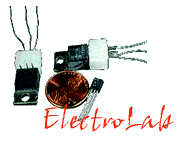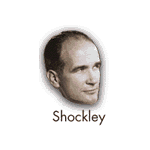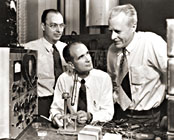






![]()
BIPOLAR JUNCTION TRANSISTOR:
DEVELOPMENT
click here to learn more about the scientific aspects of this
transistor
A s the name suggests, the junction or sandwich transistor was named after the design of a sandwich. The similarities between the two were obvious - they both contained two outside layers surrounding an inside layer. Just like a sandwich does not have three layers of bread, the middle layer of the junction transistor was the opposite of the two outer layers.
 Before the invention of the junction
transistor, the point-contact transistor was invented. We won't delve into how the
point-contact transistor worked (there is a separate section for this), but according to
the theories surrounding how the point-contact transistor worked, no current could travel
through the middle of these crystals. Now for the junction transistor to work, William
Shockley needed the current to go straight through the middle of his sandwich.
What he did, was he applied current the one side, and checked to see if it came out the
other side. It did! And so his theory about current not being able to travel through the
middle of semiconductor crystals was disproved.
Before the invention of the junction
transistor, the point-contact transistor was invented. We won't delve into how the
point-contact transistor worked (there is a separate section for this), but according to
the theories surrounding how the point-contact transistor worked, no current could travel
through the middle of these crystals. Now for the junction transistor to work, William
Shockley needed the current to go straight through the middle of his sandwich.
What he did, was he applied current the one side, and checked to see if it came out the
other side. It did! And so his theory about current not being able to travel through the
middle of semiconductor crystals was disproved.
This excited Shockley, and he carried on working on this new type of transistor while other scientists tried to improve the older point-contact transistor.
One of the problems surrounding the junction transistor was that the middle layer (in a hamburger, this would be the patty) had to be very thin and pure.
A man by the name of Gordon Teal put an idea to Shockley to make the three layered semiconductor crystals out of one crystal. Initially, Shockley dismissed Teal's idea, but despite this, Teal kept working on it. Eventually, he did manage to make one, and allowed the current that flowed through it to last up to one hundred times longer than before.
Shockley readily agreed to replace his older crystals with this new one-piece crystal. Teal managed to make all three layers of N- and P-type out of one crystal through a process called doping. He added certain elements to the melt as he pulled it out and turned it from N-type to P-type as he did so, thus creating the three layers Shockley had envisioned.
To make the transistor useful, it had to be able to amplify a current. So what Teal and Morgan Sparks did, was they scratched away a bit of the crystal off the top, and made space to place an electrode. The electrode acted as a gate, where the small, weak current to be amplified was fed in. Eventually, during testing in 1950, a signal was fed into it and the current that came out was much larger, thus amplifying the original current! Shockley's vision of a new transistor had finally been realised.
 Though the junction transistor was
invented later than the point-contact transistor, it was still inferior in that it could
not handle very complex signals, i.e. signals that changed a lot, or varied. So what they
decided was that they needed to make the middle layer even thinner, because the current
was losing its way when it hit the middle layer. Minimizing it would make for less space
for the current to wander away. So Sparks this time, pulled the melt out even
slower than before, stirring it while doing so. In the end, he managed to get the middle
layer to be thinner than a piece of paper. This proved very useful and it did all the
things the scientists imagined it to do. It was more efficient, less noisy, and could
handle weaker signals than the point-contact transistor could.
Though the junction transistor was
invented later than the point-contact transistor, it was still inferior in that it could
not handle very complex signals, i.e. signals that changed a lot, or varied. So what they
decided was that they needed to make the middle layer even thinner, because the current
was losing its way when it hit the middle layer. Minimizing it would make for less space
for the current to wander away. So Sparks this time, pulled the melt out even
slower than before, stirring it while doing so. In the end, he managed to get the middle
layer to be thinner than a piece of paper. This proved very useful and it did all the
things the scientists imagined it to do. It was more efficient, less noisy, and could
handle weaker signals than the point-contact transistor could.
In 1951, William Shockley, at a press conference, announced the invention of a working and efficient junction transistor.